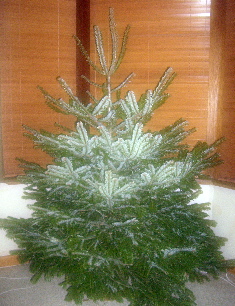publication date: Dec 19, 2009
Science: [So what? So everything] research shows that
80 per cent of parents admit to being
unable to answer their kids questions – 30 per cent
pass the buck and tell their kids to ask their partner,
20 per cent use the old classic “I’ll tell you when you are older”, while dads tend to simply
make up the answer (nine per cent). These
festive questions and answers will make sure the UK’s parents
don’t get caught out this Christmas holiday:
 Why does a Christmas cracker crack?
Why does a Christmas cracker crack?The snapper inside a cracker contains a small explosive charge which gives off a noise when you pull both ends of it. This is because the pulling forces create friction, and the friction releases heat energy. This heat is enough to ignite the small amount of gunpowder that is in the snapper, and you hear a loud ‘snap’ when you pull.
Why do icicles form on the south side of buildings?Icicles are created by repeated melting and freezing of water. The sun melts the snow during the day and it freezes in the night. Melting does not occur as frequently on the north sides of buildings, as the sun is in the south!
Why do we grit the roads?Adding impurities to water affects the temperature at which it freezes and boils. Adding grit means that water will freeze at a lower temperature, and may not freeze at all.
Why do we get red noses when it gets cold?Cold dry air is not good for the lungs, so your body sends extra blood to the nose to warm the air as it arrives – this is why you get a runny nose too!
How fast is a sneeze?
The average speed of a sneeze is more than 100 miles per hour! Have you ever noticed that you close your eyes when you sneeze? The reflex involves muscles in the face, throat and chest.
Why does wearing layers help keep us warm?Layers of clothing trap layers of air, which helps insulate us. Whales and seals depend on a thick layer of body fat called blubber, which on a whale can be 60cm thick!
Why does glitter sparkle?Glitter sparkles because it is made from lots of very tiny mirroring pieces of plastic. The light bounces off each piece in a different direction, so sometimes light will bounce back straight into your eyes and sometimes it will bounce back in a different direction. As you – or the glittery object - moves, the different light beams will hit your eyes, giving the effect of a shimmering surface.
Why does a Christmas tree shed its needles?
Christmas trees drop their needles because they’ve been taken out of their natural environment. Botanist Dr Chris Thorogood from the University of Bristol says: “When a Christmas tree is cut and brought indoors, it experiences water loss, causing stress to the tree. This environmental stress leads to the production of chemical signals that ‘seal off’ the attachment point of the needles, causing them to drop.”
For more information visit www.direct.gov.uk/sciencesowhat
 Why does a Christmas cracker crack?
Why does a Christmas cracker crack? The average speed of a sneeze is more than 100 miles per hour! Have you ever noticed that you close your eyes when you sneeze? The reflex involves muscles in the face, throat and chest.
The average speed of a sneeze is more than 100 miles per hour! Have you ever noticed that you close your eyes when you sneeze? The reflex involves muscles in the face, throat and chest.